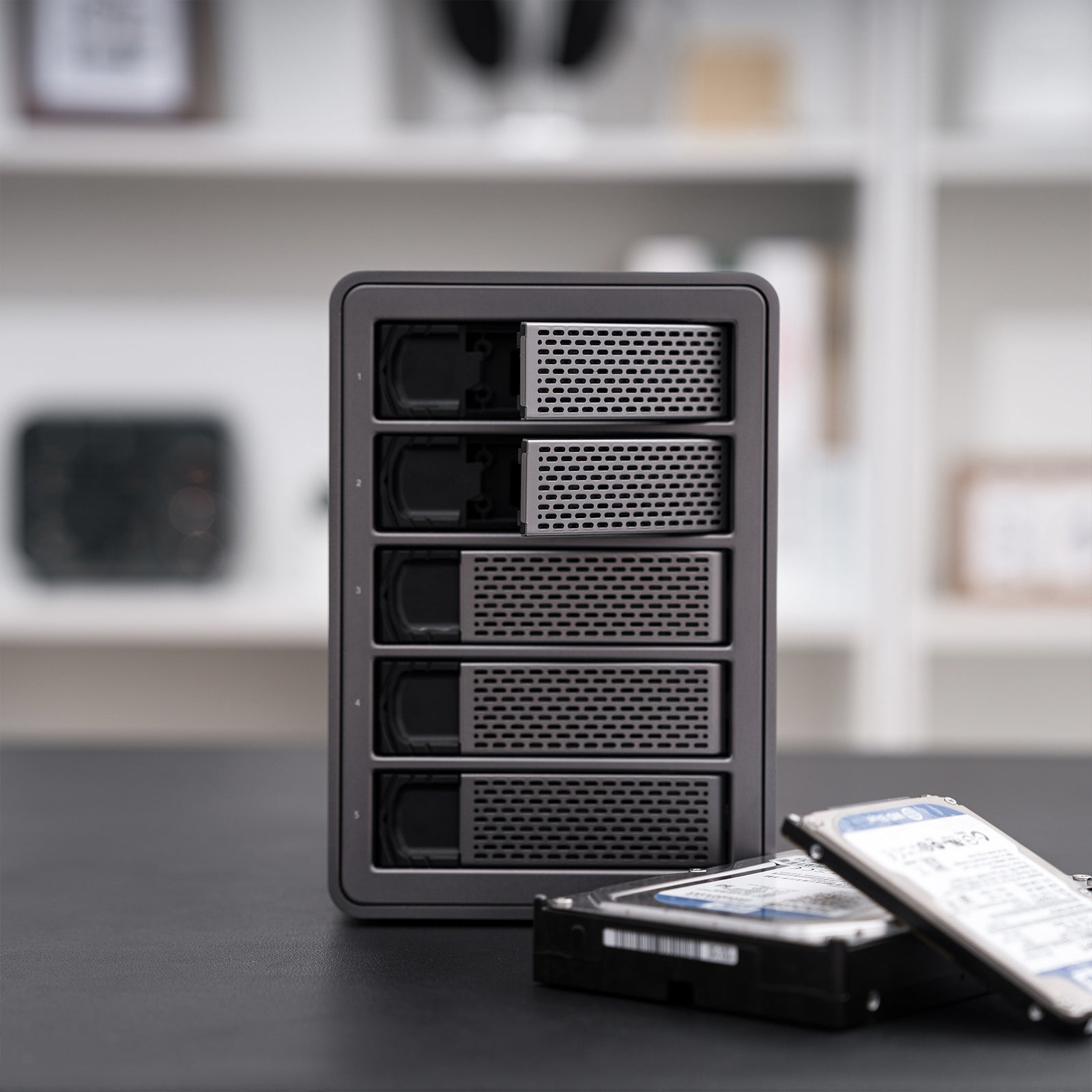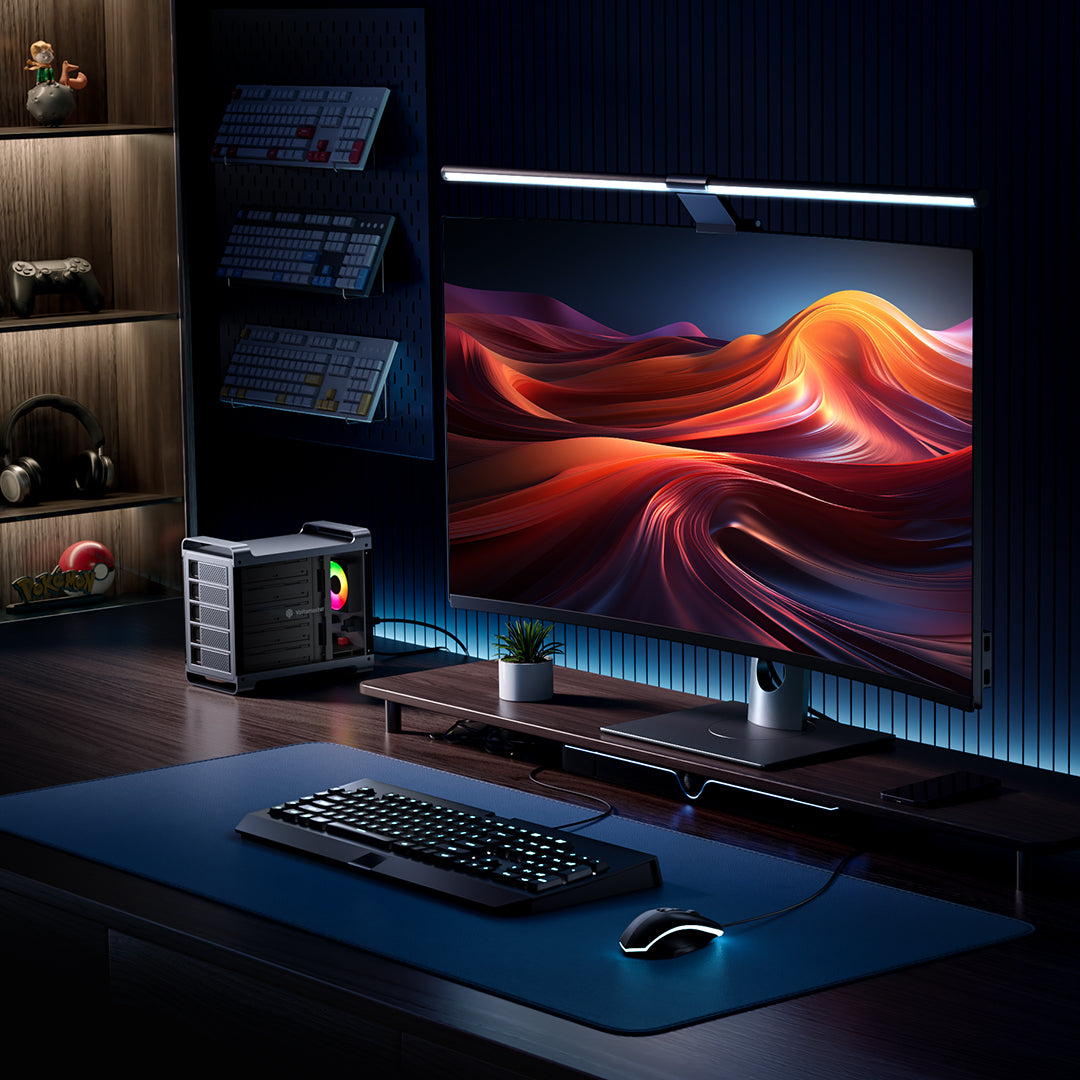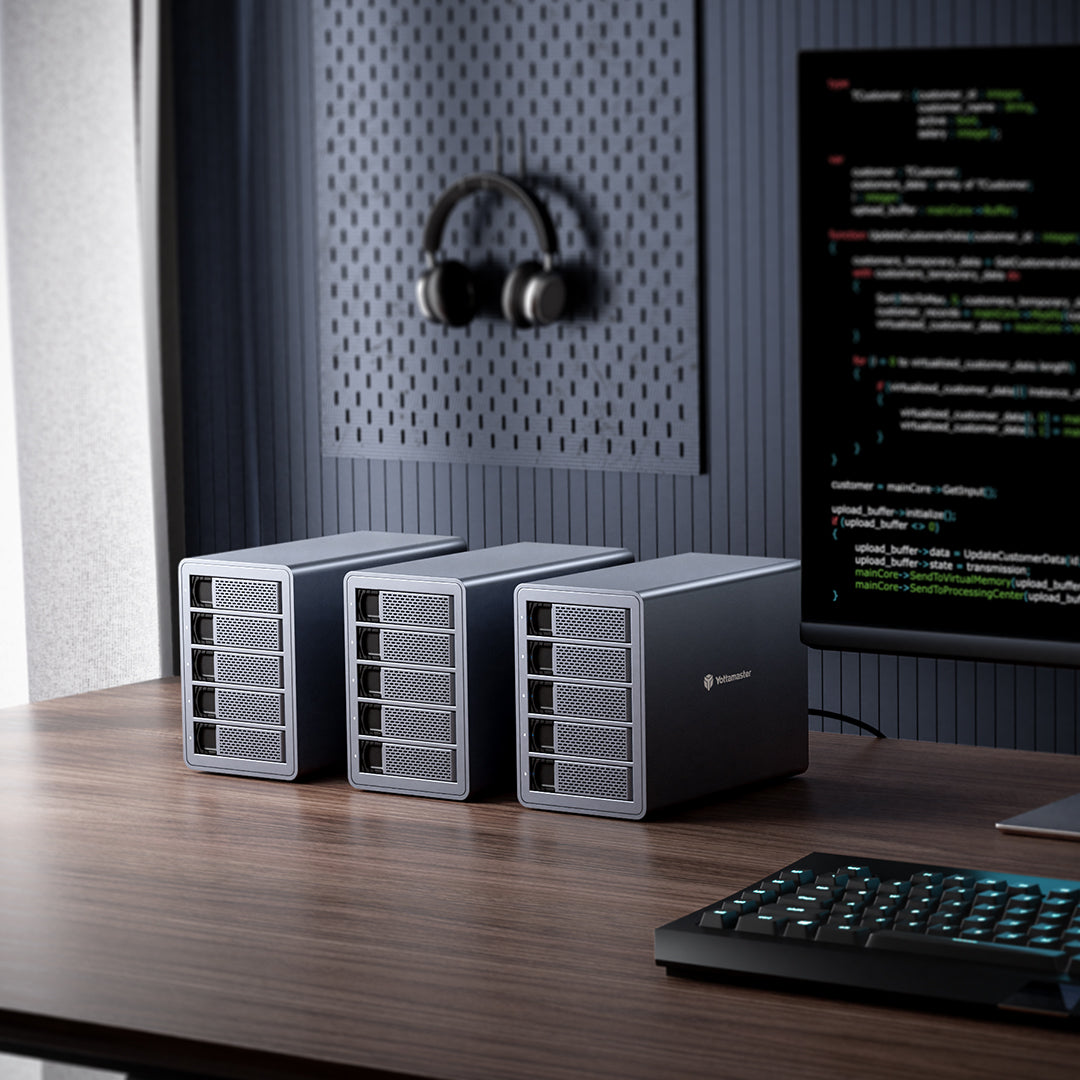January 25, 2021 by Peter Paul
Yottamaster Defender 4-Bay RAID(DF4RU3) External Hard Drive Enclosure Review

NNAS or Network Attached Storage is quite common these days. They are primarily used to store and backup data. However, a NAS requires that it is attached to the network’s router; thus the name network-attached storage. What if you just need a storage solution that can be connected directly to a PC? Enter DAS or Direct Attached Storage. Today, let’s check out one of Yottamaster’s DAS, specifically the DF4RU3 – a 4 bay RAID External Hard Drive Enclosure. The Yottamaster DF4RU3 supports up to 64TB capacity and is capable of RAID 0,1,3,5,10 and other modes like span, clone, normal/single. If you are in the market for such a storage solution, stick around, and please continue reading our Yottamaster DF4RU3 review below.
In This Review
Yottamaster DF4RU3 Review – 4 Bay RAID External Hard Drive Enclosure USB3.0.
Packaging and Closer Look.
Yottamaster RAID Manager Software.
Yottamaster DF4RU3 Benchmark Results
Pricing and Availability
Yottamaster DF4RU3 4 Bay RAID External Drive Enclosure Review Conclusion
Yottamaster DF4RU3 Review – 4 Bay RAID External Hard Drive Enclosure USB3.0
The DF4RU3 is just one of Yottamaster’s storage solutions. The company primarily sells storage solutions like external hard drive enclosure, M.2 enclosures, docking stations, and other storage related devices/accessories. A little fun fact, “Yotta” is the largest decimal unit prefix. Most of us are familiar with Mega, Giga, and Tera. Yotta is on top of that scale, and it has a base 10 value of 1024; or in the English word, it is equivalent to a septillion.
The DF4RU3 model name is somewhat hard to remember, similar to how monitor manufacturers name their monitors. But it is a 4-bay external hard drive enclosure that has RAID capabilities. It uses USB3.0 as its connection, specifically a 5Gbps USB Type-B connection. There is also a non-RAID version, the DF4U3; and if you need a 5-bay solution Yottmaster has the DF5RU3 and DF5U3 as well. If you are looking for a much faster solution or a DAS that uses a USB Type-C (10Gbps) and can be daisy-chained, Yottmaster has the FS5C3 and FS4C3.
Yottamaster says they are planning to release a Thunderbolt version later this year.For now, let’s focus on the DF4RU3.
Is this for gamers?
Interestingly, they are marketing the DF4RU3 as a “gaming-grade” storage solution, or for those who have a lot of games in their library. Personally, for gaming, I wouldn’t use any hard disk drive for my active game library. For backup or (cold) storage, perhaps yes; so that I don’t have to download the entire game if ever I decide to delete it on my SSD.
However, I would not use any hard drive or external hard drive enclosure for gaming, especially if they are limited in speed. That would only increase loading time and some elements, effects, or texture may not load instantly with a slow hard disk drive.
On the flip side, aside from storing your non-active game folders, the DF4RU3 is a great solution for storing your gameplay recordings, and other large file-sized media. So, for gaming-specific use, I wouldn’t use this. But for media storage, yes, this is definitely a useful storage solution. Let’s take a closer look at the product below.
Packaging and Closer Look
Provide useful, relevant information. Show prospects how to use your product, give them instructions or how-tos, and/or entertain them.



The Yottamaster DF4RU3 comes in a somewhat large rectangular box. You can see photos of the product from the retail box and read some of its features and specifications on the side and at the back.
Inside the box, there is a thick foam that supports and protects the DF4RU3 and another smaller box that houses the accessories included in the box. Aside from the enclosure itself, the package includes the following: a user manual; mounting screws for SSD, mounting screws for HDD; a screwdriver; a USB Type-B to Type-A cable, and a power chord.
There is no (external) power brick included since it is built-in inside the enclosure. This makes the DF4RU3 a bit heavier compared to other external enclosure that doesn’t have their power supply built into the unit. So it’s a pro and con situation, depending on how you look at it.



Above, you can see the front and front-side view of the DF4RU3. It looks stylish and has a nice aesthetic. The design reminds me of Apple’s Power Mac G5 desktop PC. It is mostly metal on the outside making it very sturdy and robust. Whereas, its sides are covered with a clear acrylic side panel.
The drive bays are numbered, with the top bay being the first one. There are no LED indicators or any buttons on the front portion. Only the drive bays can be seen at the front.



At the back, you can see the power connector, the DIP switch for the different RAID modes, a power switch, and the USB 3.0 Type-B port. You can’t see the 80mm fan from the back, but you can see a perforated Yottamaster logo where hot air can be exhausted.
Mind the DIP switch!



Yottamaster placed a guide right on top of the DIP switch to show each switch’s config value. For best practice, I suggest that you use one mode and not switch from one mode to another. You could potentially lose (all) your data if you (accidentally) mess up with the switch/settings.
In my case, I currently use and set it to normal/clear mode; where all drives are detected as individual drives in Windows. I might try other modes once I have four of the same drives in the future.

The trays for each drive seems well-constructed. To remove a tray, simply slide the lock, and the pull-tab will pop-up. The “pull-tab” is a bit awkward to pull and I feel that if the user is not careful or will forcefully pull it, it may break at some point.



Each tray is made of a combination of metal and plastic. The frame itself is solid metal, whereas the sides and the front portion is plastic. The pull tab is plastic covered with perforated metal. I guess this is to give the pull tab more rigidity. However, the joints of the pull tab and the whole mechanism (except for the spring) are plastic. So, it’s best not to yank the tray with excessive force.
I don’t see any vibration dampening on the tray or inside the drive bays. But vibration coming from the hard drives doesn’t seem to be an issue.


By the way, if there is one thing that I did not like about the design; the edges of the DF4RU3 are a bit sharp to touch. I hope Yottamaster file the edges down a bit so that it would be smooth to touch.
A peek inside the DF4RU3

I did not disassemble my unit since I do not want to damage it unintentionally. Here’s a peek of what’s inside the DF4RU3 from the drive bay’s view. You can see the SATA power and data ports from this angle.


Turning on the DF4RU3 external drive enclosure, you can see the nice 80mm fan at the back with a rainbow color effect. Unfortunately, you can’t control or change the speed and color of the fan. It has one color effect, and I think it’s a rainbow wave effect. I don’t think it’s obnoxious though, but RGB may not be for everyone.
According to Yottamaster, this is their first attempt to include an RGB fan in their product. Due to the limitations of the PCB design, they can not add additional features or controls for the RGB fan. The fan is just for aesthetics since they are marketing this external enclosure to gamers, streamers, and content creators.


Speaking of the fan, in a quiet room, the fan noise is audible. But I don’t consider it as loud or obnoxious. Some people may consider this as “noisy”, especially if they are used to very silent conditions. However, in my years of using a PC and testing several components with fans, like graphics cards or CPU coolers, the DF4RU3 isn’t the loudest I heard.
Other than the nice (RGB) lighting of the fan, there is (really) nothing to see from the inside. You can partially see the power supply area, and the Blue LED indicator for each drive bay. Nevertheless, the transparent side panels do look nice overall. Just be careful not to scratch it since it is not scratch resistant.
Yottamaster RAID Manager Software
Yottamaster has software that you can use to manage the DF4RU3’s RAID configuration. It also serves as a utility where you can check the status of the drives and update the DF4RU3’s firmware.



The unit that I got didn’t come with the latest firmware. And I was informed that it is recommended that I upgrade to the latest firmware since it includes some fix.




Like I mentioned earlier since I use the DF4RU3 in normal mode only, I didn’t have much further need of the software other than to update the firmware. But if you plan to use this external hard drive enclosure for RAID, you can use the software.
Now let’s check how the Yottamaster DF4RU3 RAID external hard drive enclosure performs.
Yottamaster DF4RU3 Benchmark Results
Since the DF4RU3 has a USB 3.0 interface and is limited to 5Gbps of theoretical speed; I have more or less a rough idea of how this external enclosure will perform. I tested the DF4RU3 with a WD Red 12TB HDD and a WD Red PRO 14TB HDD. Also, I tested it with a Samsung 870 QVO SSD to see how much performance are we going to lose if we use a much faster drive.
In the benchmark results below, you will see two results for each drive. One is “SATA Direct”, meaning this is when the drive is directly connected to my PC’s motherboard. And the other is via DF4RU3, meaning the drive is installed inside the enclosure.
ATTO Disk Benchmark Results

ATTO disk benchmark is a sequential test and will show us the best possible performance of a drive. As you can see from the results above, there is a significant loss when we use a SATA SSD in the DF4RU3. This is because it is bottlenecked by the USB 3.0 connection.
However, for the WD Red (Pro) hard drives, they perform similarly; whether connected directly to a motherboard or via the DF4RU3.
AJA System Test Drive Benchmark Results

AJA System test is mostly a sequential test and as you can see from the results above, I got similar results to the ATTO disk benchmark. The 870 QVO SSD performs best when connected directly to the PC’s motherboard. But both the WD Red and WD Red Pro hard drives perform similarly, regardless if connected directly to the motherboard or via the DF4RU3.
CrystalDiskMark Benchmark Results


Finally, I tested the drives using CrystalDiskMark, and this time random workloads are included. The results are similar to the other two tests above. The Samsung 870 QVO SSD performs best when connected to the motherboard due to the speed limitation of the DF4RU3. But it doesn’t affect much for hard disk drives since they are both slower than the SSD.
Also notice that there is a bit of performance drop. Just a tiny bit, by a few megabytes per second. I doubt that it will be noticeable at all in real-world use. Okay, time to wrap up this review.
Pricing and Availability
The Yottamaster DF4RU3 4 bay RAID external hard drive enclosure is now available and comes with an MSRP of $269.99. The company also offers a 30-day money-back guarantee, although I am not sure regarding the warranty period of this product.
Yottamaster DF4RU3 4 Bay RAID External Drive Enclosure Review Conclusion
I’ve been using the Yottamaster DF4RU3 for more than a month now, and so far so good. The built quality and its aesthetics are great and I don’t have any complaints about it. Although, I wish they would file down the edges a little bit if ever they release a similar design in the future.
At the time of writing this review, the DF4RU3 can support up to 64TB of storage capacity. That’s 16TB each drive bay. Currently, the Seagate IronWorlf Pro, Seagate Exos X16, and WD Red PRO are some of the drives that have 16TB capacities. And they are also available in 18TB capacity. Although, I am not sure if Yottamaster will release a firmware in the (near) future that would enable the DF4RU3 to support 18TB hard drives or 72TB in total.
The 80mm fan has a nice RGB lighting effect, but it can not be controlled or customized. I don’t consider the fan as noisy or obnoxiously loud, but it is audible. Surprisingly, hard drive vibration noise is kept at bay. I haven’t experienced or heard any buzzing, whirring, or vibrating sound coming from the drive bays.
The DF4RU3 has a built-in power supply, leading to some pros and cons about this design. The good side is there is no external power brick hanging or laying on the floor. It’s just the power chord directly connected to wall power. On the flip side, this makes the DF4RU3 a bit heavier and if ever the power supply becomes faulty, you’ll have to ask Yottamaster to fix the unit.
It also supports 8 different RAID modes. You can choose from RAID 0,1,3,5 or 10 and can be configured to clone a drive or just use it as “normal” or JBOD. For now, I use mine in normal mode since I still need additional drives. I don’t have any major concerns at this point, as the product is working as expected. But I wouldn’t recommend this for SSD use.
Who is this for?
In my opinion, the Yottamaster DF4RU3 is best to be used with hard disk drives and not SSDs. You’ll lose more or less half of the performance if you use an SSD due to the limitation of the USB 3.0 interface. If you want something faster, you might want to consider the Yottamaster FS4C3 instead. Since it uses a USB3.1 Type-C interface, capable of 10Gbps theoretical transfer rate.
For gamers who have their active game folders installed on SSDs, I don’t think this is for you. However, if you just want an external device to back up and save all your media files, the DF4RU3 would be a nice storage solution.
For me, I would prefer to use a DAS, rather than a NAS. It’s easier to use, just like any other external (portable) storage drive. And it’s plug and play, no need to do some network configuration or anything like that. But your mileage may vary and it primarily depends on your situation or use case.
I’m looking forward to seeing Yottamaster release a much faster version of this. Perhaps an external enclosure with a Thunderbolt interface or an enclosure with dedicated SSD drive bays. Games nowadays are getting more and more demanding, with larger file sizes, and require a much faster read/write speed.
At the end of the day, if you have multiple hard drives and you want them organized in one storage solution, the Yottamaster has several solutions for you and the DF4RU3 is one of them.




Leave a comment
This site is protected by hCaptcha and the hCaptcha Privacy Policy and Terms of Service apply.